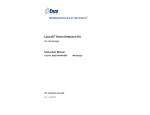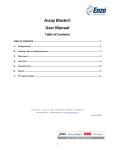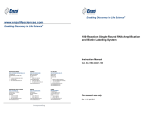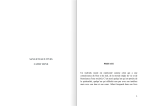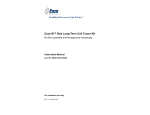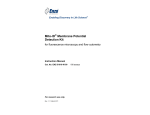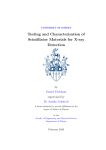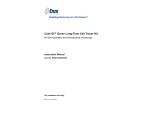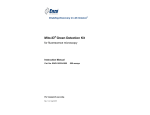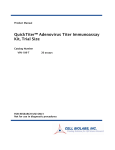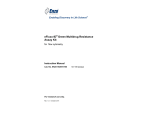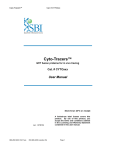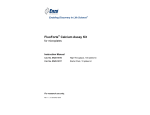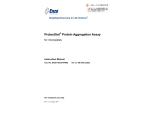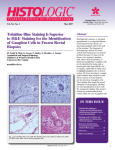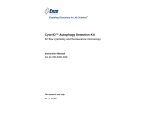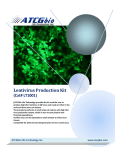Download User Manual-ENZ-51015-KP002
Transcript
Enabling Discovery in Life Science® Lyso-ID® Red Cytotoxicity Kit (GFP-Certified®) for microplates Instruction Manual Cat. No. ENZ-51015-KP002 For research use only. Rev. 1.0.1 March 2011 for 2 x 96-well plates Notice to Purchaser ® ® The Lyso-ID Red Cytotoxicity Kit (GFP-Certified is a member of the CELLestial® product line, reagents and assay kits comprising fluorescent molecular probes that have been extensively benchmarked for live cell analysis applications. CELLestial® reagents and kits are optimal for use in demanding cell analysis applications involving confocal microscopy, flow cytometry, microplate readers and HCS/HTS, where consistency and reproducibility are required. This product is manufactured and sold by ENZO LIFE SCIENCES, INC. for research use only by the end-user in the research market and is not intended for diagnostic or therapeutic use. Purchase does not include any right or license to use, develop or otherwise exploit this product commercially. Any commercial use, development or exploitation of this product or development using this product without the express prior written authorization of ENZO LIFE SCIENCES, INC. is strictly prohibited. Limited Warranty These products are offered under a limited warranty. The products are guaranteed to meet appropriate specifications described in the package insert at the time of shipment. Enzo Life Sciences’ sole obligation is to replace the product to the extent of the purchase price. All claims must be made to Enzo Life Sciences, Inc. within five (5) days of receipt of order. Trademarks and Patents Enzo, CELLestial, GFP-Certified and Lyso-ID are trademarks of Enzo Life Sciences, Inc. Several of Enzo’s products and product applications are covered by US and foreign patents and patents pending. Contents I. Introduction ............................................................... 1 II. Reagents Provided and Storage.............................. 2 III. Additional Materials Required ................................. 2 IV. Safety Warnings and Precautions........................... 2 V. Methods and Procedures ......................................... 3 A. Reagent Preparation .............................................. 3 B. Staining Live, Adherent Cells ................................. 4 VI. Appendices ............................................................... 5 A. Filter Set Selection ................................................. 5 B. Validation of Detection Reagent and Perturbing Agent .................................................... 5 VII. References ................................................................ 7 VIII. Troubleshooting Guide ........................................... 8 I. Introduction Cationic amphiphilic drugs, toxic agents and other basic compounds often show signs of large apparent accumulation in organisms, consistent with various forms of cellular sequestration. A variety of cell types are known to respond to these agents by the formation of multiple large vacuoles, which have been variously referred to as lamellar bodies or lysosomal inclusion bodies. Drug concentration into acidic vacuoles is thought to be due to ion trapping and the vacuole enlargement that follows is considered to arise from osmotic phenomena.1-4 The vacuoles generated by cationic amphiphilic drugs, such as procainamide and chloroquine, have been formally classified as autophagosomes.2-4 The persistence of giant autophagosome structures in cells is thought to be due to the retention of the stable cationic drugs by continuing ion trapping, as well as inhibition of autodigestion pathways. Repeated cycles of autophagy may also add layers of membrane to the vacuoles.4 The cytopathological sequestration of drugs within cells, leading to an excess accumulation of phospholipid-rich membranes in vacuoles, is referred to as phospholipidosis. Enzo Life Sciences’ Lyso-ID® Red Cytotoxicity Kit (GFP-Certified®) for Microplates is a 96-well cell-based assay that provides a rapid and quantitative approach for determining drug- or toxic agent-induced lysosome and lysosome-like organelle perturbations in live cells. Unlike conventional lysosome stains, this kit is effective for detecting phospholipidosis, which is induced by cationic amphiphilic drugs, such as chloroquine and verapamil. In addition to compounds that cause phospholipidosis, agents that cause the accumulation of autophagosomes by blocking the downstream lysosomal pathway and/or intracellular trafficking of autophagosomes also lead to increases in the accumulation of intracellular Lyso-ID® Red dye signal in the described assay. This microplate assay offers several advantages over alternative methods based upon electron microscopy, fluorescence microscopy, flow cytometry or long term incubation with fluorescent phospholipid analogs. Chief among these advantages are the ability to analyze drug response in cells without co-incubation with artificial phospholipid analogs and the ability to perform drug screening in a rapid and quantitative high-throughput manner using a conventional fluorescence microplate reader. A lysosome-perturbation agent, verapamil, is provided as a positive control for monitoring changes in vacuole number and volume. A blue nuclear counterstain is integrated into the detection reagent to identify cell death or loss. 1 II. Reagents Provided and Storage All reagents are shipped on dry ice. Upon receipt, the kit should be stored upright at ≤-20°C, protected from light. When stored properly, these reagents are stable for at least twelve months. Avoid repeated freezing and thawing. Reagents provided in the kit are sufficient for two 96-well plates using live, adherent cells. Reagent Quantity 10X Dual Color Detection Reagent 2 x 1 mL Detection Buffer 20 mL Verapamil Control 3 µmol 10X Assay Buffer 15 mL III. Additional Materials Required Fluorescence microplate reader Calibrated, adjustable precision pipetters, preferably with disposable plastic tips Glass microscope slides (optional) Glass cover slips (optional) Deionized water Anhydrous DMSO (optional) Serum (e.g., Fetal Bovine Serum) Growth medium (e.g., Dulbecco’s Modified Eagle Medium, D-MEM) IV. Safety Warnings and Precautions This product is for research use only and is not intended for diagnostic purposes. Some components of this kit may contain hazardous substances. Reagents can be harmful if ingested or absorbed through the skin and may cause irritation to the eyes. They should be treated as possible mutagens and should be handled with care and disposed of properly. Observe good laboratory practices. Gloves, lab coat, and protective eyewear should always be worn. Never pipet by mouth. Do not eat, drink or smoke in the laboratory areas. All blood components and biological materials should be treated as potentially hazardous and handled as such. They should be disposed of in accordance with established safety procedures. To avoid photobleaching, perform all manipulations in low light environments or protected from light by other means. 2 V. Methods and Procedures NOTE: Allow all reagents to thaw at room temperature before starting with the procedures. Upon thawing, gently hand-mix or vortex the reagents prior to use to ensure a homogenous solution. Briefly centrifuge the vials at the time of first use, as well as for all subsequent uses, to gather the contents at the bottom of the tube. A. REAGENT PREPARATION 1. Positive Control Verapamil is a cationic amphiphilic drug known to cause phospholipidosis, the accumulation of phospholipids in acidic organelles in the cells.5 Verapamil is supplied as a positive control for increasing lysosome number and volume. Reconstitute the lyophilized verapamil (3 µmoles) in 30 μL DMSO for a 100 mM stock solution. It is recommended that overnight treatment with the agent be performed using 50-120 µM final concentration in medium in order to observe changes in lysosomal signal intensity. Unused stock solution of verapamil may be stored at -20°C for several weeks. 2. 1X Assay Buffer Allow the 10X Assay Buffer to warm to room temperature. Make sure that the reagent is free of any crystallization before dilution. The addition of fetal bovine serum (FBS) to 2% is highly recommended. Prepare 1X Assay Buffer by mixing the following: 15 mL 10X Assay Buffer 3 mL Fetal Bovine Serum (FBS) 132 mL Deionized Water 3. 1X Dual Color Detection Reagent The following procedure is for preparation of 1X Dual Color Detection Reagent for use in one 96-well plate. The addition of fetal bovine serum (FBS) to 2% is highly recommended. In an appropriate size container, mix the following: 1 mL 10X Dual Color Detection Reagent 8.8 mL Detection Buffer 0.2 mL Deionized Water or Fetal Bovine Serum (FBS) 3 B. STAINING LIVE, ADHERENT CELLS The procedure described below was developed for U2OS, epithelial cell line (MCDK) and HeLa cells for which it is recommended that cells be seeded on plates at a density of 2.0 x 105 to 2.5 x 105 cells/ mL, using 100 µL cells/well. Any cell number and plate coating requirements should be optimized for the chosen cell model. Positive control cells should be pretreated with verapamil (see step A-1, page 3) overnight. Response to verapamil is time and concentration dependent and may also vary significantly among cell types and cell lines. Negative control cells should be treated with a vehicle (water, DMSO, media or other solvent used to reconstitute or dilute an inducer or inhibitor) for an equal length of time under similar conditions. 1. Seed cells in 96-well microplates, using 100 µL cells/well, the day before addition of test compound/probe. The cells should be plated such that at the end of the experiment the well should be about 90% confluent. Incubate overnight to allow the cells to grow and adhere to the plate under standard tissue culture practices. 2. After overnight incubation, treat the cells with the compound of interest under normal culture conditions for a time period sufficient for assessing the effects of the agent. For positive control, treat the cells overnight with 50-100 µM final concentration of verapamil in medium. The negative control (untreated cells) should be treated with the same vehicle used (e.g., DMSO) as the test cells. 3. After incubation with the compound of interest, carefully aspirate the medium and dispense 100 µL of 1X Assay Buffer (from step A-2, p3) to each well. 4. Carefully aspirate all the buffer and dispense 100 µL of the 1X Dual Color Detection Reagent (from step A-3, p3) to each well. 5. Protect the samples from light and incubate for 30 minutes at room temperature. 6. Wash the cells twice with 200 µL of 1X Assay Buffer each wash. Remove all excess buffer and add 80 µL 1X Assay Buffer to each well. 7. Analyze the plate with a fluorescence microplate reader. It is recommended to acquire data as soon after completing the assay as feasible. The red lysosome stain can be read with a Texas Red filter (Excitation ~540 nm, Emission ~680) and the blue nuclear counterstain can be read with a DAPI filter set (Excitation ~340, Emission ~480). If the blue nuclear counterstain signal decreases by more than 30%, the compound is considered generally cytotoxic. Increases in the red lysosome signal, without significant loss of blue signal, indicates the accumulation of the probe within the cells arising from an increase in lysosome or lysosome-like vesicle size and/or number. 4 VI. APPENDICES A. Filter Set Selection The selection of optimal filter sets for a fluorescence microplate application requires matching the optical filter specifications to the spectral characteristics of the dyes employed in the analysis. Consult the microplate reader or filter set manufacturer for assistance in selecting optimal filter sets for your microplate reader. Figure 1. Absorption and fluorescence emission spectra for the red lysosome stain (A) and the blue nuclear counterstain (B). All spectra were determined in 1X Assay Buffer. B. Validation of Detection Reagent and Pertubing agent Lysosomes are membrane-bound subcellular organelles involved in the degradation of macromolecules and pathogens in diverse processes including endocytosis, phagocytosis and autophagy. The red fluorescent probe is selectively sequestered in acidic organelles by a mechanism involving protonation and retention within the organelles. Through careful selection of titratable groups on the probe, labeling has been expanded into the lysosome-like vacuoles of cells pretreated with weakly basic, cell-permeant compounds, such as the anti-arrythmic drug verapamil. The U2OS cells, pretreated overnight with 100 µM verapamil show a dramatic increase in lysosome-like vesicle number and volume, confirming that the probe associates with this subcellular compartment. The probe can be employed for highlighting lysosome-like organelles under certain conditions, wherein cells produce lysosome-like bodies that contain most of the degradative enzymes of the lysosome, but are not as acidic as the parent organelle. Using a conventional fluorescence microplate reader, the half maximal effective concentration (EC50) of verapamil of 36 M was estimated (see Figure 2). The high Z-factor scores obtained, using this assay, demonstrate excellent signal-tonoise and signal-to-background ratios. 5 This organelle profiling toolkit can provide a screening tool to help researchers in selecting a successful candidate compound with low or weak lysosome-perturbing activity for further drug development efforts, as well as providing preliminary benchmarking of dosing limits in preclinical toxicity studies. It may also be effective in screening compounds in cell-based models of various lysosomal storage diseases. Figure 2: Using a conventional fluorescence microplate reader, the half maximal effective concentration (EC50) of verapamil in U2OS cells was estimated. The high Z-factor (0.87 for 100 µM verapamil) obtained using the assay demonstrates excellent signal-to-noise and signal-to-background ratios. The error bars denote the standard deviation of at least six determinations. The red line with diamond markers denotes the red fluorescent lysosomal signal, and the blue line with square markers denotes the blue nuclear signal. Figure 3: Composite bright-field and fluorescence microscopy images demonstrating staining of U2OS cells with Dual Color Detection Reagent. Cells pretreated overnight with a perturbing agent are shown in the right panel. 6 VII. References 1. Anderson N. and Borlak J: Drug-induced phospholipidosis FEBS Lett. 2006. 580: 5533–5540. 2. Morissette, G., Moreau, E., C.-Gaudreault, R., Marceau, F., 2004. Massive cell vacuolization induced by organic amines such as procainamide. J. Pharmacol. Exp. Ther. 310, 395–406 3. Morissette, G., Moreau, E., C.-Gaudreault, R., Marceau, F., 2005. Nsubstituted 4-aminobenzamides (procainamide analogs): an assessment of multiple cellular effects concerning ion trapping. Mol. Pharmacol. 68, 1576–1589. 4. Morissette, G., Lodge, R. and Marceau, F. 2008 Toxicol. and Appl. Pharmacol. 228, 364–377. 5. Lemieux, B., Percival, M.D., Falgueyret, J.-P., 2004. Quantitation of the lysosomotropic character of cationinc amphiphilic drugs using the fluorescent basic amine Red DND-99. Anal. Biochem. 327, 247-251. 7 VIII. Troubleshooting Guide Problem Potential Cause Suggestion Acidic organelles are not sufficiently observed. A low concentration of the Dual Color Detection Reagent was used or the reagent was incubated with the cells for an insufficient length of time. Either increase the reagent concentration or increase the time allowed for the dye to accumulate in the lysosome. Acidic organelle signals are too low to be readily quantified. Insufficient cell concentration Increase the number of cells per well. The ideal concentration is ~90% confluency. Insignificant difference between untreated cells and induced cells observed Insufficient removal of excess stain Carefully remove all liquid during the wash steps by aspiration. A second aspiration is recommended to remove all remaining liquid. If the problem persists, additional wash steps may be added. Dual Color Detection Reagent fails to stain acidic organelles in fixed and/or permeabilized cells. The dye is only suitable for live Use the dye only for live-cell -cell staining. analysis. Precipitate is observed in the 10X Assay Buffer Precipitate forms at low temperatures. Allow solution to warm to room temperature or 37°C, then vortex to dissolve all precipitate. Blue nuclear counterstain signal is dramatically reduced in treated cells. The compound is generally cytotoxic. If the blue nuclear signal decreases by more than 30%, the compound is generally cytotoxic. Optimize the concentration of the perturbing reagent. Cells do not appear healthy by microscopic examination. Some cells require serum to remain healthy. Add serum to the detection reagent and wash solutions. Serum improves staining. Typical amounts of serum to add range from 2% to 10%. Verapamil-treated cells appear The EC50 of Verapamil may dead or are no longer attached differ with different cell lines to the plate surface. Try lowering the dose of verapamil, or shortening the time of exposure. 8 www.enzolifesciences.com Enabling Discovery in Life Science® NORTH/SOUTH AMERICA GERMANY UK & IRELAND ENZO LIFE SCIENCES INTERNATIONAL, INC. 5120 Butler Pike Plymouth Meeting, PA 19462-1202 USA T 1-800-942-0430/(610) 941-0430 F (610) 941-9252 E [email protected] ENZO LIFE SCIENCES GMBH Marie-Curie-Strasse 8 DE-79539 Lörrach Germany T +49/0 7621 5500 526 Toll Free 0800 664 9518 F +49/0 7621 5500 527 E [email protected] www.enzolifesciences.com ENZO LIFE SCIENCES (UK) LTD. Palatine House Matford Court Exeter EX2 8NL UK T 0845 601 1488 (UK customers) T +44/0 1392 825900 (from overseas) F +44/0 1392 825910 E [email protected] www.enzolifesciences.com www.enzolifesciences.com SWITZERLAND & REST OF EUROPE BENELUX FRANCE ENZO LIFE SCIENCES AG Industriestrasse 17, Postfach CH-4415 Lausen Switzerland T +41/0 61 926 89 89 F +41/0 61 926 89 79 E [email protected] www.enzolifesciences.com ENZO LIFE SCIENCES BVBA Melkerijweg 3 BE-2240 Zandhoven Belgium T +32/0 3 466 04 20 F +32/0 3 466 04 29 E [email protected] www.enzolifesciences.com ENZO LIFE SCIENCES c/o Covalab s.a.s. 13, Avenue Albert Einstein FR -69100 Villeurbanne France T +33 472 440 655 F +33 437 484 239 E [email protected] www.enzolifesciences.com












